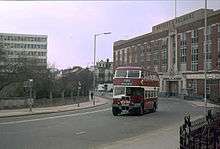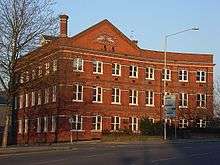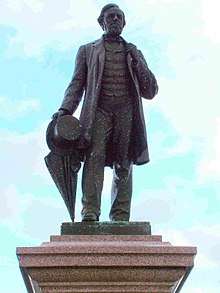Huntley & Palmers
Huntley & Palmers is a British firm of biscuit makers originally based in Reading, Berkshire.[1] The company created one of the world's first global brands and ran what was once the world’s largest biscuit factory. Over the years, the company was also known as J. Huntley & Son and Huntley & Palmer.
 | |
| Biscuit maker | |
| Founded | 1822 |
| Founder | Joseph Huntley |
| Headquarters | Sudbury, Suffolk, England |
| Website | huntleyandpalmers |


In 2006, Huntley & Palmers resumed operations and was re-established in Sudbury, Suffolk. Since 1985, the New Zealand firm Griffin's Foods has made Huntley and Palmers biscuits under licence.[2]
In 2017 conservators found a 106-year-old fruitcake from the company in the artefacts from Cape Adare. The artefact is believed to have been part of the rations of Captain Robert Falcon Scott’s Terra Nova Expedition in 1910-1913.[3]
History
Joseph Huntley
Huntley & Palmers was founded in 1822 by Joseph Huntley as J. Huntley & Son. Initially, the business was a small biscuit baker and confectioner shop at number 119 London Street, Reading, Berkshire. A blue plaque is displayed outside. The building is now home to Age UK Berkshire. At this time London Street was the main stage coach route from London to Bristol, Bath and the West Country.
One of the main calling points of the stage coaches was the Crown Inn, opposite Joseph Huntley's shop, and he started selling his biscuits to the travellers on the coaches. Because the biscuits were vulnerable to breakage on the coach journey, he started putting them in metal tins. Out of this innovation grew two businesses: Joseph's biscuit shop that was to become Huntley & Palmers, and Huntley, Boorne, and Stevens, a firm of biscuit tin manufacturers founded by his younger son, also called Joseph.[4]
George Palmer

In 1838 Joseph Huntley was forced by ill-health to retire, handing control of the business to his older son Thomas. In 1841, Thomas took as a business partner George Palmer, a distant cousin and member of the Society of Friends. George Palmer soon became the chief force behind its success, establishing sales agents across the country. The company soon outgrew its original shop and moved to a factory on King’s Road in 1846, near the Great Western Railway. The factory had an internal railway system with its own steam locomotives and one of these has been preserved near Bradford.[5]
Thomas Huntley died in 1857, but George Palmer continued to direct the firm successfully aided by his brothers, William Isaac Palmer and Samuel Palmer, and subsequently by his sons, as heads of the company. They became biscuit makers to the British Royal Family and in 1865 expanded into the European continent, and received royal warrants from Napoleon III and Leopold II of Belgium. At their height, they employed over 5,000 people and in 1900 were the world's largest biscuit firm. The origins of the firm's success lay in a number of areas. They provided a wide variety of popular products, producing 400 different varieties by 1903, and mass production enabled them to price their products keenly. One source of flour was Hambleden Mill, a few miles down the Thames. Every week a barge, Maid of the Mill brought flour upriver from the mill.[6]
The Palmers were notable local figures in Reading who generously gave money and land to Reading, including Palmer Park and the town was often known as "biscuit town". Reading F.C. football team was also known as the "biscuit men".
Exports
Another important part of their success was their ability to send biscuits all over the world, perfectly preserved in locally produced, elaborately decorated, and highly collectible biscuit tins. The tins proved to be a powerful marketing tool, and under their easily recognisable image Huntley & Palmers biscuits came to symbolise the commercial power and reach of the British Empire in the same way that Coca-Cola did for the United States.
The tins found their way as far abroad as the heart of Africa and the mountains of Tibet; the company even provided biscuits to Captain Scott during his 1910 expedition to the South Pole. During the First World War they produced biscuits for the war effort and devoted their tin-making resources to making cases for artillery shells.
In 1970, following the merger of the Scottish biscuit companies, Crawford's, McVities and McFarlane Lang and in order to respond to that market competition, the three main English biscuit manufacturers, Huntley & Palmers, Peek Frean and Jacobs amalgamated together as Associated Biscuits.
Manufacturing in Reading ceased in 1976. In 1982 Nabisco acquired Associated Biscuits. Production continued at Huyton until 1983. After the closure of the Peek Frean factory at Bermondsey in 1989, Nabisco sold the Associated Biscuit brands (Huntley and Palmers, Peek Frean, and Jacobs) to Danone.[7]
The firm manufactured over 400 different types of biscuits over the years and innovated many new types of biscuits including the Nice biscuit.
Archives
A history of the company, Quaker Enterprise in Biscuits: Huntley & Palmers of Reading, 1822–1972 by T. A. B. Corley, was published in 1972 on the firm's 150th anniversary. The historic company archive is now housed at the Reading Museum, where there is a gallery devoted to the company. Some archive films of the Huntley & Palmers factory are available for viewing in the special Huntley & Palmers gallery in the museum in the Town Hall[8]. The business archive is located at the Special Collections of the University of Reading.
Hidden images
In the 21st century it came to light that one freelance artist commissioned to design biscuit tins for Huntley & Palmers (including one based on an original artwork by Kate Greenaway[9]) had placed secret images in his designs, such as depictions of copulating dogs, copulating people, and a man with a cannabis joint.[10]
Re-establishment
In 2006, Huntley & Palmers resumed operations from Sudbury in Suffolk. The management team included a former marketing director of Jacobs Bakery, which once owned the company, and a founder of Vibrant, a successful packaging design company. They targeted the specialty and fine food sector.
Since 2008, Huntley and Palmers have been owned by the Freeman family, with three generations in the biscuit business. Their aim is to bring the name of Huntley and Palmers back into the mainstream, with several products ranges focusing on different market sectors, and including, once again, biscuit tins.[11]
See also
References
- "The Huntley & Palmers Collection - Homepage". www.huntleyandpalmers.org.uk.
- "The History of Huntley & Palmers - The Crackers that Conquered the World". Retrieved 2011-01-20.
- "100 year old fruit cake found in Antarctica's Oldest Building - Antarctic Heritage". Antarctic Heritage.
- Reading History Trail. Huntley and Palmers Archived January 17, 2010, at the Wayback Machine, Retrieved 10 October 2005
- "VIDEO: Hope you're chuffed with your present!". Bradford Telegraph and Argus.
- "Memories of Hambledon". Buckinghamshire Family History Society. Retrieved 31 January 2018.
- "Biscuit Time: a brief history of Huntley and Palmers" (PDF).
- "Huntley and Palmers Gallery". Reading Museum.
- Milmo, By Cahal (16 April 2004). "Saucy scenes and one man's revenge that took the biscuit". The Independent. Retrieved 8 April 2018.
- "Biscuit tin sex secrets revealed". BBC News. Retrieved 8 April 2018.
- "Huntley & Palmers - About Us". Huntley & Palmers. Archived from the original on 2007-04-30.
External links
| Wikimedia Commons has media related to Huntley & Palmers. |
- Web site of the Huntley & Palmer's Collection at the Reading Museum
- Official website of the British re-established Huntley & Palmer's business
- Official website of Huntley and Palmers of New Zealand
- Selection of aerial photographs of the Huntley and Palmers factory in the 1920s from the Britain from Above collection